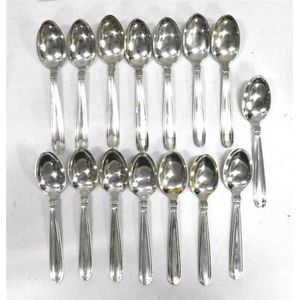Victorian Albany Silver Spoon Set
You must be a subscriber, and be logged in to view price and dealer details.
Subscribe Now to view actual auction price for this item
When you subscribe, you have the option of setting the currency in which to display prices to $Au, $US, $NZ or Stg.
- Marrow Spoon - A spoon with a long handle and a narrow scoop shaped bowl, used to scoop and eat marrow from the hollow centre of roasted bones. Some marrow scoops are double ended with a different shaped bowl at each end.
- Sterling Silver - Sterling silver is a mixture of 92.5% pure silver and 7.5% of another metal, usually copper. Fine silver is 99.9% pure silver, and is relatively soft and the addition of the very small amount of copper gives the metal enough strength and hardness to be worked into jewellery, decorative and household objects.
- Victorian Period - The Victorian period of furniture and decorative arts design covers the reign of Queen Victoria from 1837 to 1901. There was not one dominant style of furniture in the Victorian period. Designers used and modified many historical styles such as Gothic, Tudor, Elizabethan, English Rococo, Neoclassical and others, although use of some styles, such as English Rococo and Gothic tended to dominate the furniture manufacture of the period.
The Victorian period was preceded by the Regency and William IV periods, and followed by the Edwardian period, named for Edward VII (1841 ? 1910) who was King of the United Kingdom and the British Dominions and Emperor of India for the brief period from 1901 until his death in 1910. - Albany Pattern - The Albany pattern is a design of sterling silver cutlery (silverware) that was popular in the 19th century. It is characterized by a simple, elegant design with a plain handle and a pointed tip. The pattern is named after Albany, New York, where it was first produced by the firm of Rogers, Smith & Co. in the 1850s. The Albany pattern is considered a classic design and is still popular today. It is typically used for formal occasions and is often paired with fine china and crystal.
This item has been included into following indexes:
- silver cutlery / flatware, patterns - Albany pattern 6
- spoons, silver
Visually similar items

Large collection of 18th / 19th / 20th century Bead and Old English cutlery. Mixed marks. There is a matched complete set for twelve lunch forks & spoons, dinner fork & spoons, tea spoons as well as ladles etc, 6735 grams (ex thirty two knives)

Sterling silver cutlery set, 29 pieces by maker Black Starr and Frost (purchased Cartier in 1962), approx. 1.625kg (Black Starr and Frost, French silversmith opened in New York in 1810, elite Royal Award winning jewellers to Prince of Wales, Vanderbilts, R

Fifteen Danish sterling silver spoons with grape & fluted detail. Wt 547 grams

Selection mixed sterling silver cutlery, including a pair of fiddle pattern table forks, 3 fiddle pattern dessert spoons, sterling silver handled cake slice, 5 various Old English & fiddle pattern teaspoons etc (16)
